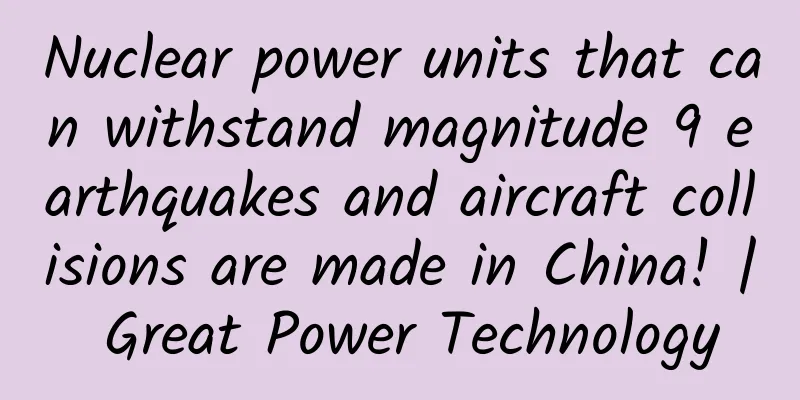Nuclear power units that can withstand magnitude 9 earthquakes and aircraft collisions are made in China! | Great Power Technology

|
China's "Sky Eye", Shenzhou spacecraft, Mozi "message", high-speed rail, Beidou network, supercomputer "power", large aircraft first flight, domestic aircraft carrier and fifth-generation aircraft... 2012-2022, in the ten years since the 18th National Congress of the Communist Party of China, the Chinese people have made countless inspiring scientific and technological achievements. China's dream of "catching up with the world" has achieved a historic leap. As the People's Republic of China celebrates its 73rd birthday, the Digital Beijing Science Center has compiled for our audience the remarkable scientific and technological advances since the 18th National Congress of the Communist Party of China, and grandly launched a series of special pictures and texts titled "Science and Technology of a Great Power - Ten Years of Great Changes and Technological Take-off", reviewing with everyone the scientific and technological achievements made by our great motherland under the leadership of the Party in the past decade. Audit expert: Wang Peng Senior Director of the Publicity Department of China Nuclear Engineering Have you ever seen a nuclear power plant ? In the media, for example, in reports on the Fukushima nuclear accident, nuclear power plants are placed in front of the camera, making people see them clearly, as if they are right in front of them; in reality, few people have seen the majesty of nuclear power plants, and even fewer people know about them and feel that they are very far away from them. In fact, nuclear power plants may have already been quietly improving your life, and they may even be less than a hundred miles away from you. Qinshan Nuclear Power Plant Source: Wikipedia As of the end of last year, China had 51 nuclear power units connected to the grid, with a total installed capacity of 53.275 million kWh, second only to the United States and France in the world; at the same time, China is still building 20 nuclear power units with a total installed capacity of 21.429 million kWh, ranking first in the world. If the total electricity consumption of the people across the country in 2021 is 100 kWh, then 4.8 kWh of it was generated by nuclear power plants. Last year, China's nuclear power generation totaled 40.7141 million kWh, requiring only about 1,160 tons of nuclear fuel. If it were replaced with burning standard coal to generate electricity, it would require about 116 million tons , and 1.45 million open coal trucks with a load capacity of 80 tons would be needed. How long is this? If the rear of the truck is in Wangfujing, Beijing, then the front of the truck can park directly on the lawn of the White House in the United States. Burning so much coal will produce 300 million tons of carbon dioxide . If trains are also needed to transport it, such a long train will be enough to circle the equator! What's even more surprising is that a nuclear power plant may be built not far from you. How far is the Qinshan Nuclear Power Plant from Shanghai as the crow flies? 45 kilometers. Why can the Daya Bay Nuclear Power Plant conveniently supply electricity to Shenzhen and Hong Kong? Because it is only 40-50 kilometers away from these two highly developed regions. Daya Bay Nuclear Power Station Source丨Nuclear Power The reason why they can't be discovered by you is because they are quiet enough and safe enough . Where is the nuclear power plant “hidden”? Nuclear power plants usually use fissionable nuclides such as uranium or plutonium as fuel, causing them to produce a self-sustaining chain reaction in the reactor, converting the energy released in the process into electricity. This process sounds simple, but its implementation is extremely technically complex. Coupled with the complex upstream and downstream supporting industrial chains, nuclear power firmly occupies a high-end position in all current energy systems. At the same time, because nuclear power is a high-quality, efficient and clean energy, and the carbon equivalent produced per unit of electricity generation is only 1/2 of wind power, 1/10 of hydropower, and 1/13 of photovoltaic power generation, it has become a key development area of clean energy that has attracted global attention. It is recognized as a basic power source for stable power supply in the power grid, namely base load power. Neutrino experimental device in the nuclear reactor of Daya Bay Nuclear Power Plant Source: Wikipedia However, it is undeniable that nuclear power relies on radioactive substances to generate electricity. Once natural disasters or man-made disasters occur, the consequences of nuclear leakage accidents will be disastrous. Therefore, on the one hand, people are concerned about the construction and operation of nuclear power plants, and on the other hand, they have put forward higher requirements and expectations for the safety of nuclear power plants. One of the important aspects of ensuring the safety of a nuclear power plant is choosing a suitable construction location . Although the construction of a nuclear power plant does not require consideration of coal resources and transportation conditions like the construction of a thermal power plant, nor does it require vast space and special natural conditions like wind power and photovoltaic power generation, there are still many factors worth considering. Firstly, it should be remote enough , especially far away from big towns and cities, so that in case of accidents, the losses will not be too great. Secondly, it should not be too remote , at least not too far away from the city where electricity is mainly supplied, otherwise it will be uneconomical. Secondly, the geographical environment and geological structure should be stable , and the surrounding area should not be prone to mountain torrents and mudslides. The terrain should be as high and open as possible, which will not be easily disturbed by groundwater and will also be conducive to the dispersal of exhaust gas. Finally, it is best to be as close to a water source as possible , such as the sea or a river. This is not only necessary for the normal operation of the nuclear power plant, but also provides better conditions for crisis management. With the ideal factory site in hand, it’s time to consider the most important issue. What kind of nuclear power plant is the safest? Of course, the more advanced, the safer, such as nuclear power plants that use third-generation nuclear power technology ! The construction of the world's first generation of nuclear power plants began in the Soviet Union and the United States. In 1954, the Soviet Union built the world's first nuclear power plant, but it was small and mainly for experimental research. Just three years later, the United States also built its own nuclear power plant. After discovering that nuclear power was feasible, countries such as Canada and the United Kingdom quickly followed suit and began to develop the nuclear power industry. From the 1970s to the end of the century, after preliminary verification of the safety and economy of nuclear power plants, the United States, Russia, France, Japan, Canada and other countries began to design and build second-generation commercial reactors on a large scale to make them more standardized. The development of nuclear power in the world ushered in a climax. China began to develop nuclear power plants in the 1980s. On the one hand, it was based on the rich technical strength accumulated in the development of nuclear submarine nuclear power reactors. On the other hand, it was able to introduce mature nuclear power technology from the United States, France and other countries, digest and re-innovate it, and overcome difficulties and obstacles. It took nearly 30 years to finally blaze a path for independent, advanced and efficient nuclear power technology research and development and application with world-leading nuclear power plant safety levels , and achieved the goal of catching up with the old nuclear power powers in the third-generation nuclear power technology. The new "sarcophagus" installed in 2017 after the accident at the Chernobyl nuclear power plant Source: Wikipedia Since the 1970s, people have experienced major and tragic accidents such as the Three Mile Island Nuclear Power Plant, the Chernobyl Nuclear Power Plant, and the Fukushima Nuclear Power Plant. Compared with the second generation, the third generation of nuclear power technology focuses on improving the safety of nuclear power plants, while also putting forward higher requirements on the performance indicators and economy of nuclear power units. my country's "Hualong One", with independent intellectual property rights, is an outstanding representative of the third-generation nuclear power technology. How safe is the Hualong One? "Hualong One" has excellent genes. China National Nuclear Corporation and China General Nuclear Power Group Corporation have introduced nuclear power technologies from the United States and France respectively on the basis of long-term independent research and development, and developed and created two nuclear power unit technologies, ACP1000 and ACPR1000+. Later, they integrated and improved the two to form the "Hualong One", an internationally recognized third-generation nuclear power technology with independent intellectual property rights and independent brand. Aerial photo of the nuclear power unit of Fuqing Nuclear Power Plant in January 2021 Source: Xinhuanet At present, the "Hualong One" unit has not only achieved localization of most of its core equipment, with an overall localization rate of 88%, but is also considered by experts from international organizations to be sufficiently mature and reliable in terms of safety design and innovative design. "Hualong One" implements the principle of nuclear safety defense in depth and designs multiple safety protection schemes: First of all, the standard safety barrier designed for my country's nuclear power plants is implemented: uranium dioxide ceramic core blocks lock in radioactive materials, zirconium alloy fuel cladding further blocks radioactive materials, a 20-centimeter-thick steel pressure vessel encloses the core, and a 1.3-meter-thick reinforced concrete plant building is lined with a 6-mm-thick steel lining to form a containment vessel. "Hualong One" also adopts a unique double-layer containment design, with the inner layer preventing the spread of radioactive materials and the outer layer able to withstand external shocks, such as commercial flight collisions. The "Hualong One" model on the float Source: China Nuclear Industry News In addition, the active and passive safety systems are also a highlight, that is, not only can the safety function be realized by external power drive, but also natural driving forces such as gravity, temperature difference, density difference, etc. can be passively utilized to realize fluid flow and heat transfer and realize safety functions. The Hualong One has been specially designed to resist earthquakes of magnitude 9. The more dispersed layout of the plant can also effectively reduce the risk of concentrated equipment failure caused by fires and floods. Compared with the core design of 157 fuel assemblies commonly used in mainstream nuclear power plants, the innovative 177 sets of 12-foot fuel assemblies not only increase the power of the power generation stack, but also reduce the power density inside the core, thereby improving the level of operational safety. With multiple safety measures, Hualong One can prevent accidents from escalating without operator intervention within 30 minutes after an accident occurs, and can respond to accidents without external assistance within 72 hours after an accident occurs. In terms of reliability, the design service life of the power plant has also been increased from 40 years to 60 years, and the core refueling period has been extended from the usual 1 year to 1.5 years. On March 25, 2022, the second unit of the "Hualong One" demonstration project, Unit 6 of the Fuqing Nuclear Power Plant, was officially put into commercial operation. This marks the full completion and operation of the "Hualong One" demonstration project. At the same time, Hualong One has also settled in Zhangzhou, Fujian, Fangchenggang, Guangxi, Changjiang, Hainan and other places. The number of units in operation and under construction has exceeded 10, which is also a microcosm of its mass construction in China. As one of the most internationally promising third-generation nuclear power technologies, "Hualong One" has gone abroad and left a mark of friendly cooperation in Pakistan, Türkiye and other countries. In fact, China has mastered more than just the "Hualong One" third-generation nuclear power technology, including the extremely powerful CAP1400 . Not only has it made breakthroughs in the third-generation light water reactor and high-temperature gas-cooled reactor technology, but it is also in a leading position in the research of fourth-generation lead-cooled fast reactors, sodium-cooled fast reactors, molten salt reactors and other technical lines. As ordinary people, we don’t need to bite the bullet to figure out the advantages and disadvantages of these “piles” or worry about the risks. We just need to have enough confidence in the development of nuclear power in my country and live our lives in peace. While enjoying the clean energy provided by nuclear power, we should have enough respect for the pioneers and successors in the field of nuclear power and be proud of them! |
<<: Wen Xiaogang: What is a quantum bit? | The Door to Wonders
Recommend
Mysterious creatures in the ocean have mastered fiber optic technology that surpasses humans
If you dive in the warm Indian-Pacific waters nea...
How to choose a promotion channel that suits you based on the characteristics of short video channels?
There are new ideas every year, but this year the...
What are the main functions and effects of Cordyceps sinensis? How much does Cordyceps sinensis cost per gram?
Cordyceps sinensis is a very precious medicinal m...
Siri will be the highlight of Apple Developer Conference: it may open the interface and land on Mac
Apple's revenue fell in the first quarter for...
Does eating steamed bread and bread fermented with yeast really hurt your stomach? Here is the truth!
Today we are going to talk about things related t...
How to carry out a successful scenario-based content marketing?
Good copywriting is like a love letter, which mak...
Does crackling in your joints mean arthritis? The answer may not be what you think
gossip “Crackling joints are arthritis!” In daily...
"Cliff-like aging" really exists! Scientists reveal two key time points for accelerated aging of the human body
Tuchong Creative Such plots often appear in movie...
China Energy Media Research Institute: Energy price trend analysis report in April 2022
Core Tips 1. International crude oil market In Ap...
Can anti-blue light glasses protect your eyes and prevent myopia? Attention! Not everyone is suitable for wearing them...
Expert of this article: Li Zongou, Master of Opht...
Tik Tok advertising, the complete process of information flow promotion, targeting precise users!
For a complete Douyin advertising campaign, the i...
Samsung is serious! Announced the establishment of a VR content studio in the United States
According to the latest news from foreign media, ...
What exactly is AirGig, the black technology that uses wires to transmit network signals?
At the MWC 2017 conference, which has ended, peopl...
Will your ID card and mobile phone be demagnetized if placed together? How many of these 7 common problems in life do you know?
Will my ID card be demagnetized if I put it behin...
Waste becomes fuel, wood itself can't imagine
Forestry is an important support for the construc...









